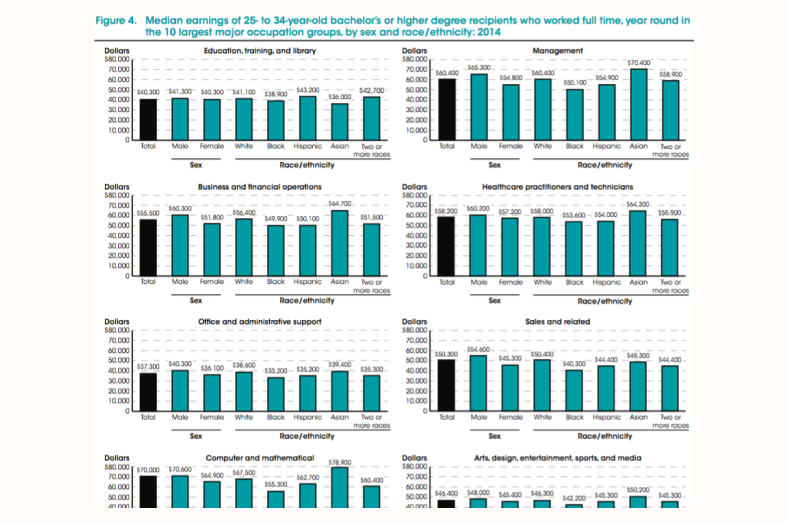

Whites, blacks, Asian-Americans and Hispanic-Americans are all graduating from college at higher rates now, but stubborn racial and gender gaps are widening, a new federal report finds. Women earn more college degrees than men but receive lower wages, while whites and Asian-Americans continue to earn bachelor’s degrees at higher rates than blacks and Hispanics.
The findings come from The Condition of Education 2016, an authoritative annual snapshot of educational progress in the United States, released Thursday by the National Center for Education Statistics.
Across all four-year institutions, the graduation rate for first-time students seeking bachelor’s degrees was 60 percent in 2014, which represents a slight increase since 2000, when 57.5 percent of first-time students graduated. The government calculates the graduation rate by counting the number of students who entered college and completed their degrees within six years.
But some racial groups have earned bachelor’s degrees at higher rates than others, increasing the gap significantly between the college degree attainment of whites and Asian-Americans and that of blacks and Hispanic-Americans.
According to the federal data, between 1995 and 2015 the percentage of white 25-29-year-olds attaining bachelor’s degrees has risen from 29 to 43 percent, a gain of 14 percentage points. Among blacks, the percentage with bachelor’s degrees has gone up by only six points, from 15 to 21 percent, and for Hispanics it has risen seven points, from 9 to 16 percent. Asians and Pacific Islanders lead all groups, having raised their graduation rate for bachelor’s degrees from 43 to 63 percent. (Data for Native Americans doesn’t reach back to 1995; in 2015, the bachelor’s graduate rate for this group was 15 percent.)
Women overall continue to have greater postsecondary success than men: In 2015, 39 percent of women aged 25 to 29 had completed a bachelor’s degree, while the same was true for 32 percent of men.
Across all racial and gender groups, the percentages for completing at least an associate’s degree were higher than the graduation rates for bachelor’s degrees. Wages tend to be higher for bachelor’s recipients than those earning associate’s degrees. The number of students receiving either degree has risen dramatically since 2003: a 51 percent increase in associate’s degrees (from 665,300 to over 1 million) and a 34 percent increase in bachelor’s degrees (from 1.4 million to 1.9 million).
Wages varied widely between racial and gender groups, even for those working in the same sectors of the economy and having similar academic credentials. While 86 percent of adults with at least a bachelor’s degree between the ages of 25 and 34 were employed in 2014, males were working at higher rates – 90 percent to 83 percent. The employment levels were nearly identical between white and black workers with bachelor’s degrees, and slightly lower for Hispanics.
But in virtually every one of the 10 major economic sectors, men out-earned women and white workers were paid more than black or Hispanic workers. Asian workers had generally higher wages than white workers with bachelor’s degrees.
Some of the variance in overall wages may have to do with differences in the types of jobs each demographic group pursues, the report notes. “One factor contributing to the Asian-Black earnings gap is that 20 percent of Asian young adults with a bachelor’s degree or higher were employed in computer and mathematical occupations, one of the top paying job groups examined, compared to 5 percent of Black young adults,” the report’s authors write.
This story was produced by The Hechinger Report, a nonprofit, independent news organization focused on inequality and innovation in education. Read more about Higher Education.